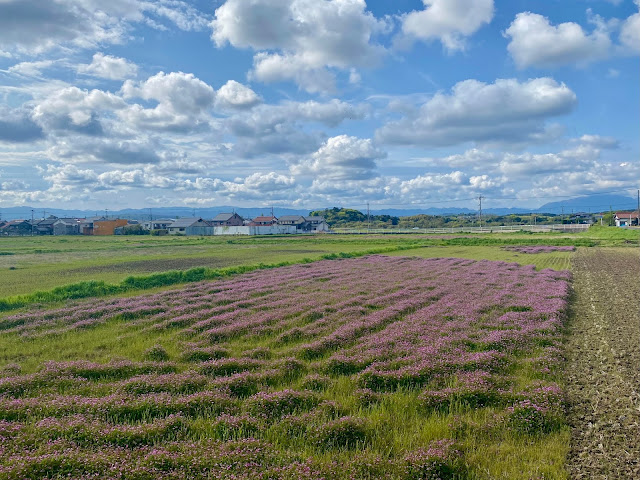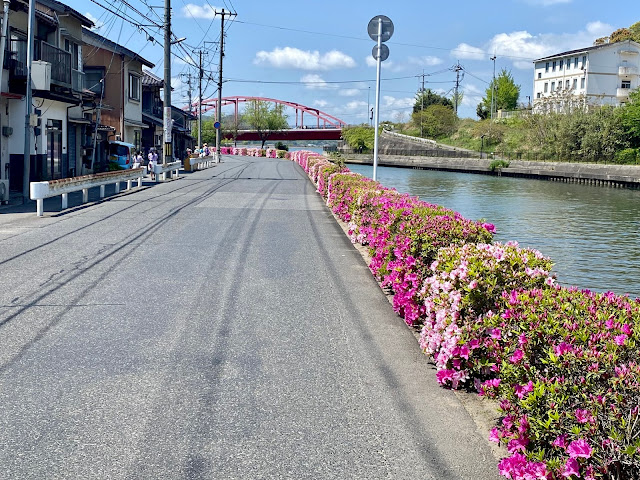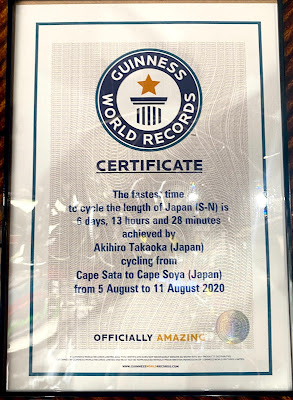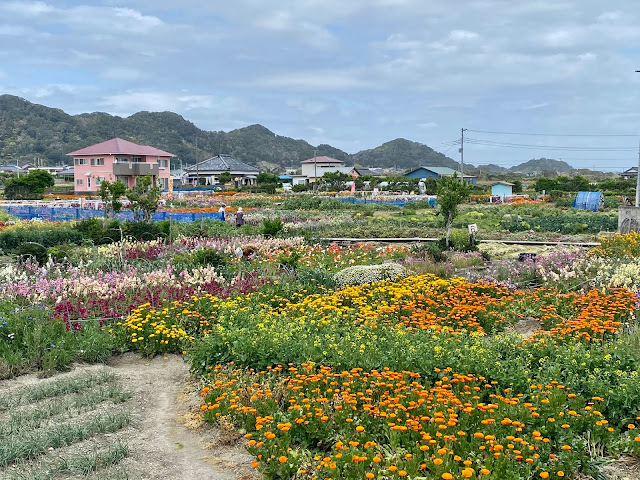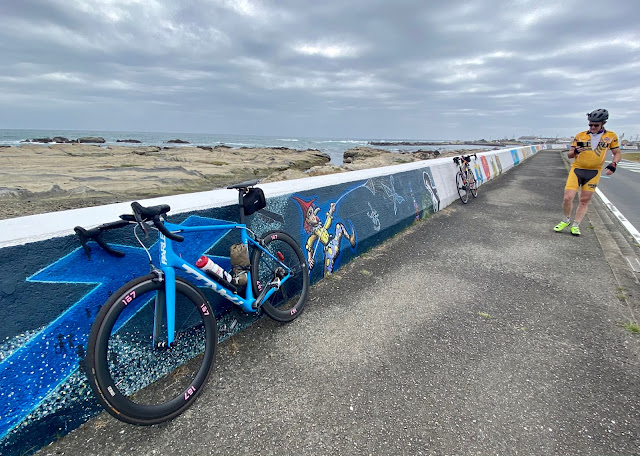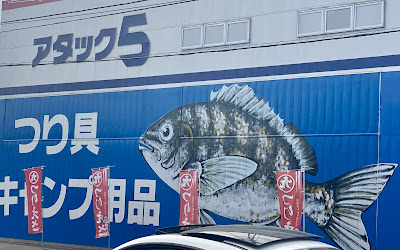 |
| On the stretch between Bizen and Sayo, Day 1, Okayama |
Jerome and I have these past five years agreed that the 2016 Okayama 1200km ride was the best long randonnée we have done in Japan. The scenery is varied and lovely, and very Japanese. You can take in BOTH the Sea of Japan, and the Inland Sea, not to mention plenty of mountains, in one ride. And you pass through many lovely historical spots and travel many hundred of kilometers of safe, quiet roads. Plus the ride is scheduled at end of April just before Golden Week, usually some of the best riding weather of the year, when the countryside is full of flowering trees.
2016 was the first time this ride was held, so riders showed up from all over the world. Lest we forget, there is a photo of Jerome and me at the eat-in Lawson store in Sayo-gun, next to Micky Inagaki (then Chair of Japan Audax), Mark Thomas (then head of Randonneurs USA, now president of Les Randonneurs Mondiaux), and Peter Heal (record holder for the fastest human powered vehicle trip across Australia, and another record for AROUND Australia), with Yoshida-san down at the end.
I was in very good shape then, having completed in 2015 the usual prep series (200, 300, 400, 600km rides) as well as an SR600 and several more events, the 1200km Paris-Brest-Paris, mountainous week of Giro del Dolomiti, Cycle Oregon, along with many other epic rides, bicycle commuting to the Keio Shonan Fujisawa campus weekly on many Wednesday afternoons. I was down to my "fighting weight". And I did 2016 early season 200, 300, and 400km events before the Okayama ride.
 |
| The Sea of Japan, Day 2, Izumo |
We were eager to join the second running of the event in 2020. But last year, Okayama 1200 was postponed due to Covid-19. All Audax rides in Japan were cancelled or postponed in the Spring/summer. And I did not join any of the rescheduled ones in the Fall. I did get in many nice short rides near town in Spring, and decent training rides in Nagano in August/early September, but nothing over 150kms. My only planned semi-epic ride, in September, ended on the evening of day one (out of three) when I broke my collarbone. The broken bone kept me off the bike entirely for a few months. I finally recovered and started to rebuild with the Festive 500 at year end and then two early January 2021 200km brevets.
My plan was to do two 300km brevets in March and early April in order to have some claim to being ready for Okayama. Both were cancelled as a result of our early-year Covid-19 emergency declaration in Tokyo and nearby. Jerome and I did substitute rides, but each was much shorter. They confirmed what I already knew -- all of his bicycle trips from Nagoya back to Tokyo (how many -- 3? more? since last Fall) and other crazy riding has made him incredibly powerful, a much faster rider than I am, especially going up hills. He just stays on the big ring and motors away.
And Jerome started riding regularly with Peter J. last fall. I have joined some, and Peter and I have done some rides without Jerome. It is great to find another rider who has a similar approach, wants to get out regularly on the west side of town, stick to very small groups, and rides without a lot of advance notice. But I have joined only a small fraction of their rides and often need to drop off and circle back to town when they are just getting going. Jerome's training with Peter has added to his long distance solo trips to keep him in top condition.
Meanwhile, this year I am definitely not at my fighting weight but 8-10% heavier. (Indeed, I am hoping that if Japan ever gets its act together for Covid-19 vaccinations, I might even shrink my height a cm or so, gain a couple kgs, and qualify for an early vaccination based upon high BMI.)
 |
| When you see lots of signs for 補聴器 (hearing aids), you know you are in an area with more than a few elderly. |
So how was I going to complete the rescheduled 2021 Okayama 1200, with extra body weight, five years older, and with far poorer physical preparation? Well, in hindsight the odds were not that good, at least not good for doing it without a lot of punishment. But I figured that I had a decent shot.
--Since I did this ride once before, I had a big leg up. I knew the course! It was nearly the same this time as last, after all. Sure, the 2021 route takes the Shimanami Kaido instead of going to Kure and out along a different chain of bridges connecting islands, but that is immaterial. Most of the checkpoints are the same, or just a few kms down the same road as before.
Here are the 2016 and 2021 maps, omitting the different (but equally easy) "island segments" SW of Onomichi.
The 2016 version
--I knew that if I could only make it to Onomichi, I could "roll home" the last 35% of the ride (other than that one detour north to Fukiya, with the lovely descent back south). If I could somehow manage to get through the first day to Kurayoshi and then the climbs to Hiruzen Highland and Daisan on the second morning, I could relax a bit and just slog it out. Sure, my extra weight would make me a bit slower on the climbs, but this ride never tops 800 meters elevation, nothing like the mountain passes of Nagano.
--And last time hadn't the first night been a disaster -- trying for an hour to sleep on cardboard on freezing cold dirt inside a barn .. then shifting for a few more to a tiny open floor space in an oxygen-deprived, overheated room full of riders? This time without the organizers arranging communal sleeping space (Covid-19 precautions), I would reserve hotels, and send ahead a box with a change of clothes, snacks, spare tire tubes, etc. And last time I had ridden the last 450kms without the use of my big chainring, due to a front derailleur failure. This time I would not "spin out" at 28-29kph but could make a faster top speed when merited.
--I would ride the Sky Blue Parlee, a slightly faster bike, with a better Busch Mueller front light, and carefully selected gear so that I could make good time with minimum effort. I wanted as much "resting on the bike" as possible -- going at 26-27kph with <50% effort, instead of 30-31kph with >70% effort. Above all, I would start out without pushing too hard. And I would make sure to try and get good rest the last two nights before the start.
--We rationalized that doing longer brevets really is not so valuable for training. It mostly just proves that you HAVE trained, that your body can withstand prolonged punishment. It does not actually get you ready for MORE such punishment. Indeed, if anything, the 2x300km plan would have required a prolonged recovery period ... especially as one gets a bit older. On that theory, replacing the 300km rides with shorter 150km/200km versions could actually help us complete the Okayama 1200. That was the plan.
Peter J. had decided he would meet us in Onomichi and ride the Shimanami Kaido/Matsuyama round trip section with us on the third day. It would be great to have someone to offer a bit of moral support (though actual physical support -- drafting, or mechanical help outside a checkpoint, from a non-participant -- violates Audax rules).
The night before the event, when looking at the brevet card I had been given that afternoon, I realized that the control points were nearly all "通過 check" -- in other words, there was no interim time cut-off! The only exceptions were the 313km control point just west of Tottori-shi, and the 1207km finish. This meant I could relax and not stress over the Hiruzen and Daisan time cut-offs. Whew. But if I had missed that ... had I missed anything else? Micky Inagaki would not have been happy with me. He taught me that careful planning is the key to completing these events, and I was clearly winging it if I had not caught this crucial detail. At least this would work in our favor, and we could enjoy some very good Italian style pizza a few minutes' walk from our hotel.
 |
| Kurashiki, near our hotel |
 |
| Italian style pizza, Italian beer, nice label |
 |
| Oversized sign above the (somewhat useless for randonneur gear) bicycle shop across from our hotel |
The first problem arose with the "get good rest" part. I had a work-related Zoom call planned from the hotel for 9PM before the ride. I tried (but failed) to sleep on the train down from Tokyo that morning. I tried (but failed, barely) to sleep in the hotel before dinner. Then the call took longer than expected, and required some follow-up on my part that night, instead of waiting until after the ride. So it was nearly midnight when I slept. I managed only 3 hours of sleep, then was awake, quickly got changed, and was out of the hotel at 330AM, riding to the 4AM start.
The first hour or two went very well. Our route skipped the first, highest section of the hills from 2016 on the way to the coast and the Seto Ohashi. Hmmm. Not quite the same route as last time.
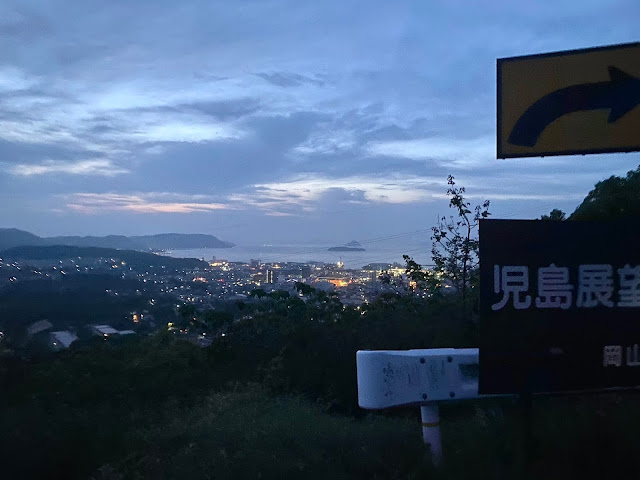 |
| First light from a hillside. |
 |
| Proof of passage. Seto Ohashi. |
 |
| This seems like some kind of aquaculture complete with residences or at least work huts. Solar PV in the background on the hillside. |
After getting to the coast, the route zigs and zags but generally heads East-Northeast to Bizen city. On Saturday, we enjoyed a wind from the East-Northeast. It was not a vicious wind, but it was enough so that you could not actually "rest on the bike", but needed to work to make any decent progress.
The headwinds stayed with us all morning, the first 7-8 hours of the ride, then were no longer a problem in the afternoon. But they had sapped significant energy before the hills became endless.
We took a different road than in 2016 part of the way inland between Bizen and Sayo. This was barely noticeable on the map of the entire route, and the high point on the segment was no higher than last time, but this time seemed to have more up and down. When I later checked, the 2021 RidewithGPS for the first 220kms had added an extra 50% more climbing (2800m instead of 1900m). Not much good for "resting on the bike"!
Indeed, the total elevation gain for the 2021 1200km route on RidewithGPS shows 16,550 meters, as compared to 11,690m in 2016. A typical 1200km randonee does have around 12,000 meters (39,000 ft) of elevation gain. But nearly 5000m more? That was something I really should have picked up on. Of course, RidewithGPS elevations are not accurate and can be pretty significantly excessive--they often omit tunnels and measure as if you were going over rather than through the mountain. Be that as it may, the relative course elevations were different, and we had no more tunnels this time than last.
As another example, on the ~200km segment between Uppuruifusha Park (十六島風車公園) on the Sea of Japan and the bottom of a long descent past Sera heading toward Onomichi on the Inland Sea, both courses go over the same mountain range, peaking just above 700 meters elevation. But the 2016 Riddewithgps course shows 2271m of elevation gain, while the 2021 course shows 3281m.
How could I have missed an extra 1000 meters? Well, at least some of that elevation was hidden in stretches this year such as the one after Miyoshi, where we went up and down and up and down endlessly, on a local road without much grading and no tunnels, never higher than 300m nor lower than 150m elevation. It reminded me of our Fleche crossing Kyushu from Oita to Kumamoto on a similar road -- it wiped out our team as we ended up walking up the steepest hills in the wee hours and failed to complete our minimum 24-hour distance. These roads can be great for training, but are soul-destroying on the third day of an ultra-endurance event!
(*Looking at some actual Strava recordings of riders who completed both events, it seems the 2016 route had 10,400m actual elevation gain, and this year had 12,000m ... in both cases with the climbing packed into the first 700kms. So not an extremely hilly event, just a very hilly first 60%.)
Enough about the route. The ride was still spectacular. Despite my 30 minute head start, Jerome caught me shortly after the "Olive Garden" checkpoint at 103kms. He was entering as I was leaving. This spot is still at the top of a steep hill, with a beautiful view of the Inland Sea. |
| Socially distanced checkpoint |
Pretty quickly Jerome caught me again, and soon moved ahead. I just could not keep up. And the weather got warm, not summer hot, but the hottest ride of the year so far for me, as the ground got hillier. A few hours later I caught up with him as he finished lunch at a roadside Chinese style restaurant. He waited while I also had a bite to eat and some liquids. Then we were over a few more hills and to Sayo. Jerome again went ahead. His hotel reservation in Kurayoshi had a 10PM deadline when they closed up and locked the door. That set an ambitious target.
 |
| Somewhere in the NW corner of Hyogo Prefecture |
 |
| Checkpoint before the climb to Tottori ... and the pre-climb climb. |
I was glad just to be finally on the last climb out of Hyogo Prefecture to the border with Tottori. ... except it was not the last climb. It was a side climb within Hyogo up to 500m elevation, followed by a tunnel and fast descent down to 250m ... before the long gradual 25km climb back up to 720m elevation. The climbs were up beautiful valleys, with almost no traffic, in beautiful weather. But once past the last Hyogo checkpoint north of Sayo, I had already ridden further than any one-day ride since August 2019. And I still had 120km yet to Kurayoshi. My body was not happy with the food I was eating, nor the liquids I was drinking, and I bonked a couple times. I just kept going, trying not to push nor go into the red zone. I stopped once on the long climb for a rest, laying on my back on a bench. I could see the "iwashi gumo" (sardine clouds). I thought I could see Marc Chagall-like figures of fanciful creatures in the clouds. I planned another stop near the top with less than 100m elevation left to climb. By now it was night and getting cool, so I put on my windbreaker there before reaching the tunnel and starting the descent. Finally, on the 15km downhill, I felt good. My stomach had recovered, the bike felt "planted" well on the corners, and my light offered a much wider beam than my previous one. This made a big difference going through turns in the dark. I felt pretty good and wide awake on the flat section around the southern edge of Tottori City and all the way to the 313km checkpoint, and passed a number of riders. I got to the checkpoint at 10PM, nearly 3 hours ahead of the 12:51 cutoff.
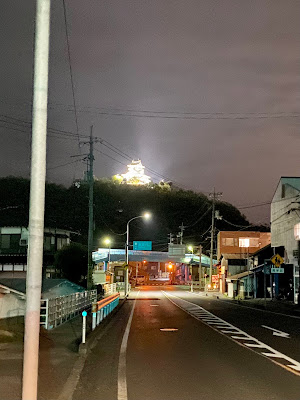 |
| Fake (modern) castle on a hill approaching Tottori City |
I should have declared victory and slept. But my hotel reservation and change of clothes awaited in Kurayoshi, 38kms ahead along the relatively flat coast. After leaving the checkpoint, I expected to join the busy coastal road, which I remembered being a bit scary with fast trucks roaring by at night in 2016. Instead, we stayed on a quiet side road a few kms inland ... that went over hills. They were not long, and not that steep. Just rolling countryside, but my progress was very slow after 300+kms of riding.
 |
| As a cyclo-tourist I could take a lot more photos. |
 |
| No-cars-allowed bridge in Yonago |
So I had a decent breakfast, and lovely, relaxed ride to Yonago in beautiful weather. I got there ahead of Jerome (who had left his hotel for the hills at 530AM or so). I continued on to Yasugi, just over the border into Shimane Prefecture, where I stopped to look at a floating solar project on a huge irrigation pond. My solar company had lost a bid for this project back in 2013-14. I made several visits there with our team members and local partner, but had not returned since, nor seen the much smaller project by a local politically-connected bidder that won.
 |
| That is a floating solar project on the far side of the pond! Barely visible ... |
I got off Route 9 and had a tasty katsu-curry lunch at a cafe in Iya, about 10 kms before Matsue. Very nice.
In Matsue, it was a long wait for Jerome, who was riding with Takatori-san, a regular Japanese brevet participant, and they needed to loop out to the first of two seaside checkpoints between Yonago and Matsue, as I took the more direct inland route via Yasugi. They had stopped for a sashimi lunch. I rested in Matsue, ate some snacks, and waited trying to keep warm outside as spitting drops of rain threatened worse and wind gusted.
It was nearly 3 hours from the time I entered Matsue to when we rode out of a 7-11 parking out after a stop on the western edge of town. I was ready to pull and go fast, and thought my #1 job now was to try and help Jerome rather than holding him back. We took turns pulling, riding with a tailwind, and made great time the 22kms west from town. But shortly after we turned north to go to the next checkpoint, at the Uppuruifusha Park, I bonked.
 |
| Part of the Orochi Loop in Autumn, photo taken from the upper bridge |
The final 25 kms to Miyoshi was relatively flat -- gradual up and downs. I was getting very sleepy, but made it okay and arrived at the Miyoshi Royal Hotel around 2:15AM. A 265km day for me, with only one big climb. The building lobby was dark ... but the hotel front door still opened. No one was at the front desk. I called out "gomen kudasai" ("hello, excuse me"). After some rumbling in the back room, a Japanese clerk appeared, bleary eyed. I thought I probably woke him up. He told me that the front desk is closed from 2AM to 6AM. Indeed, there were signs plastered all over the lobby and even in the elevators warning of this(!) ... but apparently the booking services like Agoda and Booking.com did not think to pass the info along. And this was not some minshuku, but one of two larger hotels in a mid-sized city, so I did not even think to ask.
I paid and got my room key. I told the clerk I had a friend who was arriving later. He said, speaking quite loudly, that any later reservations had already been cancelled, that the building would be locked and he would go home so he could sleep to work the next day. He asked if I would meet my friend the next day, and I said "yes". He brought out Jerome's rucksack (sent by Yamato Takkybin) and tried to hand it to me so I could deliver to my friend. I said, "wait a minute, I said I will meet him, but it may not be for another 100kms. And I cannot carry that thing on my bicycle in addition to MY rucksack. And if Jerome does not have a place to sleep, I have no idea when or where we will meet, or whether he will even live to morning." He asked when Jerome would arrive?
So I called his mobile and got him on the speakerphone. Jerome said he had just suffered a flat tire about 25 kms from Miyoshi. Worse, he had ridden some on the flat, and thought that he had destroyed the tire as well as the tube. I told him about the hotel problem. I offered to try and ride back and handover my spare tire. He declined. I called the Miyoshi Grand Hotel -- they were open 24 hours and picked up the phone immediately, but they had no spare rooms.
Anyway, Jerome quickly found a coin laundry that was open 24 hours, warm inside and with a bench he could sleep on. Classic Japanese brevet strategy. And across the way from the coin laundry was a local train station, where he could hop the early train and arrive in Miyoshi by 8AM, the train station being right next to the Miyoshi Royal Hotel. In the end, the desk clerk asked me for Jerome's mobile number, I gave it, and the clerk said in the morning that he did stay at the hotel (though he never told me he would actually do so, just hinted at it, and he never tried to call Jerome's mobile to see if he was actually going to show up before morning opening time).
 |
| Jerome and the Miyoshi commuters |
After Jerome's train ride (DNF) we were both just cyclo-tourists. And we were way behind our plan to meet Peter and start the Shimanami Kaido at 9AM. Peter would ride alone that day.
Jerome mounted the spare tire he had sent in his rucksack, and we had breakfast at the McDonalds about 500 meters back into town, in the absence of a "Gusto" this side of Onomichi, and not wanting to ride a few kms back to the "Joyfull" family restaurant up the hill on the other side of the city.
 |
| Installing a new tire outside the Miyoshi Royal Hotel |
 |
| A breakfast fit for ... royalty? |
We set off on a lovely morning for the short trip from Miyoshi to Onomichi. My ride plan had been a 5-530AM departure and a 9AM arrival at the ferry for Shimanami Kaido. It was only 80kms. Instead, we were leaving breakfast at 9:45AM. And it was slow going, first climbing out of the city on a busy road, then turning off onto the side road with its constant short ups and downs, none longer than a kilometer. After making it 15 kms, the route turned left and up the main "real" climb of the morning. Instead, we took an alternative, larger road with a sign to Onomichi. This road was a national highwy and was graded. It had a few tunnels that went THROUGH hills as it gradually climbed. In the end, we saved a few kilometers and a couple hundred meters of climbing, and ended up in the same place. With a lunch stop in Sera at a Taiwanese restaurant, it took us nearly six hours to ride the 72kms to Onomichi. We were knackered from the first 700kms. We got to our hotel in Onomichi and did not even think of riding out to catch Peter as he returned along the shimanami kaido.
 |
| A typical stretch with an 8~9% grade. |
After a nap, the three of us enjoyed a dinner of Hiroshima-style okonomiyaki, steak, and stir fried items (moyashi, etc.), cooked by a second generation okonomiyaki chef who said he had been a journalist for a Yomiuri-affiliated publication, even spending some time in New Hampshire once for his work, but who came back to take over the restaurant from his father. It was some of the best okonomiyaki I've tasted.
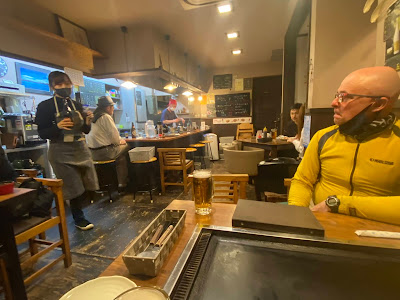 |
| Dinner at Poppoya in Onomichi - highly recommended |
Early the next morning, Peter headed for Hiroshima Airport, I had another work Zoom call then headed back home via shinkansen ... while Jerome rode his bicycle back to Kurashiki, then home by train at night!







